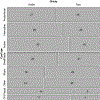Differences in autobiographical memories reported using text and voice during everyday life
- PMID: 36609199
- PMCID: PMC10085840
- DOI: 10.1080/09658211.2022.2162084
Differences in autobiographical memories reported using text and voice during everyday life
Abstract
Autobiographical memories frequently occur during everyday life. One of the most common approaches to measuring memories in everyday life is a diary method: Participants record memories as they occur by writing down these memories in a paper diary or typing them on a smartphone. Conversely, many laboratory-based studies of autobiographical memory require participants to describe their memories out loud in a spoken manner. Here, we sought to directly compare memories recorded via typing to those spoken out loud in a smartphone diary study. Participants reported or, autobiographical memories that occurred over a period of four days either by typing (n = 43) or recording themselves orally describing memories (n = 39) using a smartphone app. Results indicated that the audio recording group reported memories more frequently and these memories contained a greater number of words, while the text group reported memories more promptly after they occurred. Additionally, the typing group reported memories that were episodically richer and contained a greater proportion of perceptual details. This work has important implications for future autobiographical memory studies in the lab, online, and using diary methods, and suggests that certain reporting modalities may be advantageous depending on the specific research focus.
Keywords: Autobiographical memory; everyday life; involuntary; naturalistic.
Figures





Similar articles
-
Investigating the role of involuntary retrieval in music-evoked autobiographical memories.Conscious Cogn. 2022 Apr;100:103305. doi: 10.1016/j.concog.2022.103305. Epub 2022 Mar 9. Conscious Cogn. 2022. PMID: 35278896 Free PMC article.
-
Comparing music- and food-evoked autobiographical memories in young and older adults: A diary study.Br J Psychol. 2023 Aug;114(3):580-604. doi: 10.1111/bjop.12639. Epub 2023 Feb 13. Br J Psychol. 2023. PMID: 36779290 Free PMC article.
-
Relationship between frequency of involuntary autobiographical memories and cognitive failure.Memory. 2014;22(7):839-51. doi: 10.1080/09658211.2013.838630. Epub 2013 Oct 25. Memory. 2014. PMID: 24161129
-
[Episodic autobiographical memory in depression: a review].Encephale. 2006 Oct;32(5 Pt 1):781-8. doi: 10.1016/s0013-7006(06)76231-5. Encephale. 2006. PMID: 17099603 Review. French.
-
A review of autobiographical memory studies on patients with schizophrenia spectrum disorders.BMC Psychiatry. 2019 Nov 14;19(1):361. doi: 10.1186/s12888-019-2346-6. BMC Psychiatry. 2019. PMID: 31727046 Free PMC article.
Cited by
-
Popular music and movies as autobiographical memory cues.Mem Cognit. 2025 Aug 8. doi: 10.3758/s13421-025-01765-2. Online ahead of print. Mem Cognit. 2025. PMID: 40781454
-
Fractional amplitude of low-frequency fluctuations during music-evoked autobiographical memories in neurotypical older adults.Front Neurosci. 2025 Jan 23;18:1479150. doi: 10.3389/fnins.2024.1479150. eCollection 2024. Front Neurosci. 2025. PMID: 39917247 Free PMC article.
References
-
- Belfi AM, Bai E, & Stroud A (2020). Comparing methods for analyzing music-evoked autobiographical memories. Music Perception, 37(5), 392–402.
-
- Belfi AM, Karlan B, & Tranel D (2018). Damage to the medial prefrontal cortex impairs music-evoked autobiographical memories. Psychomusicology: Music, Mind, and Brain, 28, 201–208.
Publication types
MeSH terms
Grants and funding
LinkOut - more resources
Full Text Sources
Miscellaneous
